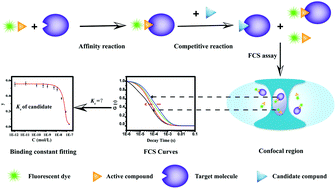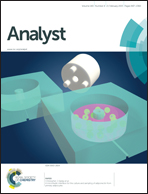A sensitive and microscale method for drug screening combining affinity probes and single molecule fluorescence correlation spectroscopy†
Abstract
In this paper, a sensitive and microscale method for drug screening is described using single molecule spectroscopy fluorescence correlation spectroscopy (FCS). The principle of this method is mainly based on the competition of candidate drugs to the fluorescent probe–target complexes and the excellent capacity of FCS for sensitively distinguishing the free fluorescent probes and the fluorescent probe–target complexes in solution. In this study, the screening of protein kinase inhibitors was used as a model, tyrosine-protein kinase ABL1 was used as a target and a known inhibitor dasatinib derivative labeled with a fluorescent dye was used as a fluorescent affinity probe. We firstly established the theoretical model of drug screening based on the binding process of fluorescent probes and targets, the competition of candidate drugs to the fluorescent probe–target complexes and FCS theory. Then, the dasatinib derivatives were synthesized and labeled with the fluorescent dye Alexa 488, and the binding and dissociation processes of Alexa 488-dasatinib and ABL1 were systematically investigated. The dissociation constant and the dissociation rate for the Alexa 488-dasatinib–ABL1 complex were determined. Finally, the established method was used to screen candidate drugs. The dissociation constants of ABL1 kinase to six known drugs for treating chronic myeloid leukemia (CML) were evaluated and the results obtained are well consistent with the reported values. Furthermore, a homemade chip with micro-wells was successfully utilized in FCS measurements as the carrier of samples, and the sample requirements were only 1–2 μL in this case. Our results demonstrated that the drug screening method described here is universal, sensitive and shows small sample and reagent quantity requirements. We believe that this method will become a high throughput platform for screening of small molecule drugs.


 Please wait while we load your content...
Please wait while we load your content...